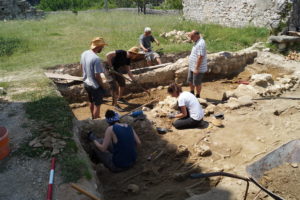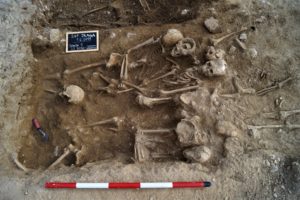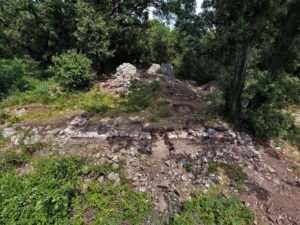 Under the supervision of project team members M. Jurković, G.P. Brogiolo, A. Chavarria and R. Starac, the international team has continued the series of archaeological researches on the island of Rab with the most recent campaign which was held from May 29th to June 12th 2017. It included the continuation of excavations in the town center, on a site known as “Kuća rapske torte” which has provided exceptionally fruitful archaeological finds in the last two years. Given the fact the single urban center of the island has been continuously populated for more than 2000 years, the importance of excavations conducted on such a site is unquestionable. New archaeological excavation has been conducted in a town’s public park “Dorka”. The research of still visible remains of one of the numerous examples of medieval religious architecture highly concentrated in the town center’s peninsula, has been carried out.
Under the supervision of project team members M. Jurković, G.P. Brogiolo, A. Chavarria and R. Starac, the international team has continued the series of archaeological researches on the island of Rab with the most recent campaign which was held from May 29th to June 12th 2017. It included the continuation of excavations in the town center, on a site known as “Kuća rapske torte” which has provided exceptionally fruitful archaeological finds in the last two years. Given the fact the single urban center of the island has been continuously populated for more than 2000 years, the importance of excavations conducted on such a site is unquestionable. New archaeological excavation has been conducted in a town’s public park “Dorka”. The research of still visible remains of one of the numerous examples of medieval religious architecture highly concentrated in the town center’s peninsula, has been carried out.
 Together with the excavations in Rab’s urban center, team members together with Croatian and Italian students have conducted archaeological excavations outside the town of Rab, since one of the main goals of CROMART project is to define the development of both the urban center as well as the historical landscape of the island. The work on the Benedictine Abbey of St Peter in Supetarska Draga, supervised by R. Starac, has been continued and has resulted in further excavation of medieval Benedictine burial site in front of the church of St Peter, one of the best preserved early Romanesque religious buildings on the Eastern Adriatic. The archaeologists, together with the help of locals, have also discovered well preserved lower parts of abbey wall structures.
Together with the excavations in Rab’s urban center, team members together with Croatian and Italian students have conducted archaeological excavations outside the town of Rab, since one of the main goals of CROMART project is to define the development of both the urban center as well as the historical landscape of the island. The work on the Benedictine Abbey of St Peter in Supetarska Draga, supervised by R. Starac, has been continued and has resulted in further excavation of medieval Benedictine burial site in front of the church of St Peter, one of the best preserved early Romanesque religious buildings on the Eastern Adriatic. The archaeologists, together with the help of locals, have also discovered well preserved lower parts of abbey wall structures.
The other project team has simultaneously carried out the research of the remains of a church on a site known as “Ciprijanovo” in Kampor area. After the preliminary vegetation clearing, archaeological sondages were made in order to define the perimeter of wall structures, endangered by the construction of a recent asphalt road. Results have confirmed the existence of two historical phases of the church, an Early Christian phase probably from the 5th c., and an earl medieval one, which proves a long lasting continuity of an important sacred place.